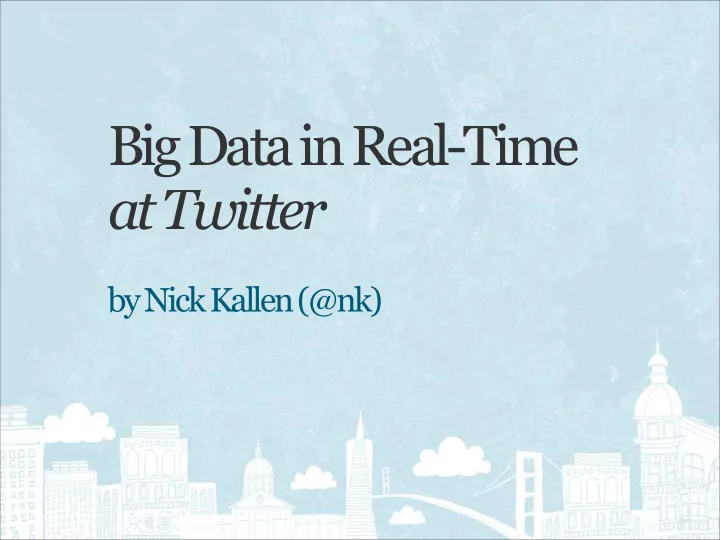

Big Data in Real-Time at Twitter by Nick Kallen (@nk)
What is Real-Time Data? • On-line queries for a single web request • Off-line computations with very low latency • Latency and throughput are equally important • Not talking about Hadoop and other high-latency, Big Data tools
The three data problems • Tweets • Timelines • Social graphs
What is a Tweet? • 140 character message, plus some metadata • Query patterns: • by id • by author • (also @replies, but not discussed here) • Row Storage
Find by primary key: 4376167936
Find all by user_id: 749863
Original Implementation id user_id text created_at 20 12 just setting up my twttr 2006-03-21 20:50:14 29 12 inviting coworkers 2006-03-21 21:02:56 34 16 Oh shit, I just twittered a little. 2006-03-21 21:08:09 • Relational • Single table , vertically scaled • Master-Slave replication and Memcached for read throughput.
Original Implementation Master-Slave Replication Memcached for reads
Problems w/ solution • Disk space : did not want to support disk arrays larger than 800GB • At 2,954,291,678 tweets, disk was over 90% utilized.
PARTITION
Dirt-Goose Implementation Queries try each Partition by time partition in order until enough data id user_id is accumulated 24 ... Partition 2 23 ... id user_id Partition 1 22 ... 21 ...
LOCALITY
Problems w/ solution • Write throughput
T-Bird Implementation Partition by primary key Partition 1 Partition 2 id text id text 20 ... 21 ... 22 ... 23 ... Finding recent tweets 24 ... 25 ... by user_id queries N partitions
T-Flock Partition user_id index by user id Partition 1 Partition 2 user_id id user_id id 1 1 2 21 3 58 2 22 3 99 2 27
Low Latency PK Lookup 1ms Memcached 5ms T -Bird
Principles • Partition and index • Index and partition • Exploit locality (in this case, temporal locality) • New tweets are requested most frequently, so usually only 1 partition is checked
The three data problems • Tweets • Timelines • Social graphs
What is a Timeline? • Sequence of tweet ids • Query pattern: get by user_id • High-velocity bounded vector • RAM-only storage
Tweets from 3 different people
Original Implementation SELECT * FROM tweets WHERE user_id IN (SELECT source_id FROM followers WHERE destination_id = ?) ORDER BY created_at DESC LIMIT 20 Crazy slow if you have lots of friends or indices can’t be kept in RAM
OFF-LINE VS. ONLINE COMPUTATION
Current Implementation • Sequences stored in Memcached • Fanout off-line, but has a low latency SLA • Truncate at random intervals to ensure bounded length • On cache miss , merge user timelines
Throughput Statistics date daily pk tps all-time pk tps fanout ratio deliveries 10/7/2008 30 120 175:1 21'000 11/1/2010 1500 3'000 700:1 2'100'000
2.1m Deliveries per second
MEMORY HIERARCHY
Possible implementations • Fanout to disk • Ridonculous number of IOPS required, even with fancy buffering techniques • Cost of rebuilding data from other durable stores not too expensive • Fanout to memory • Good if cardinality of corpus * bytes/datum not too many GB
Low Latency get append fanout 1ms 1ms <1s* * Depends on the number of followers of the tweeter
Principles • Off-line vs. Online computation • The answer to some problems can be pre-computed if the amount of work is bounded and the query pattern is very limited • Keep the memory hierarchy in mind
The three data problems • Tweets • Timelines • Social graphs
What is a Social Graph? • List of who follows whom, who blocks whom, etc. • Operations: • Enumerate by time • Intersection, Union, Difference • Inclusion • Cardinality • Mass-deletes for spam • Medium-velocity unbounded vectors • Complex, predetermined queries
Inclusion Temporal enumeration Cardinality
Intersection: Deliver to people who follow both @aplusk and @foursquare
Index Index Original Implementation source_id destination_id 20 12 29 12 34 16 • Single table , vertically scaled • Master-Slave replication
Problems w/ solution • Write throughput • Indices couldn’t be kept in RAM
Edges stored in both directions Current solution Forward Backward source_id destination_id updated_at x destination_id source_id updated_at x 20 12 20:50:14 x 12 20 20:50:14 x 20 13 20:51:32 12 32 20:51:32 20 16 12 16 • Partitioned by user id Partitioned by user • Edges stored in “forward” and “backward” directions • Indexed by time • Indexed by element (for set algebra ) • Denormalized cardinality
Challenges • Data consistency in the presence of failures • Write operations are idempotent : retry until success • Last-Write Wins for edges • (with an ordering relation on State for time conflicts) • Other commutative strategies for mass-writes
Low Latency write cardinality iteration write ack inclusion materialize 1ms 100edges/ms* 1ms 16ms 1ms * 2ms lower bound
Principles • It is not possible to pre-compute set algebra queries • Partition, replicate, index . Many efficiency and scalability problems are solved the same way
The three data problems • Tweets • Timelines • Social graphs
Summary Statistics writes/ reads/second cardinality bytes/item durability second Tweets 100k 1100 30b 300b durable Timelines 80k 2.1m a lot 3.2k volatile Graphs 100k 20k 20b 110 durable
Principles • All engineering solutions are transient • Nothing’s perfect but some solutions are good enough for a while • Scalability solutions aren’t magic. They involve partitioning, indexing, and replication • All data for real-time queries MUST be in memory. Disk is for writes only . • Some problems can be solved with pre-computation , but a lot can’t • Exploit locality where possible
Recommend
More recommend